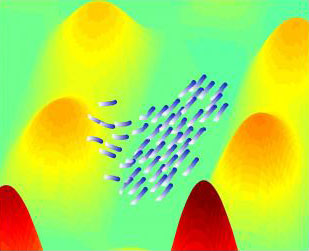Smart swarms of bacteria inspire robot design
November 21, 2011

Simulated interacting agents collectively navigate towards a target (credit: American Friends of Tel Aviv University)
Tel Aviv University researchers have developed a computational model that better explains how bacteria move in a swarm and that can be applied to computers, artificial intelligence, and robotics.
Studying the principles of bacteria navigation will allow researchers to design a new generation of smart robots that can form intelligent swarms, aid in the development of medical microrobots used to diagnose or distribute medications in the body, or gather information from the Internet on consumer behaviors, the researchers said.
Bacteria have superior survival skills. Their decision-making processes and collective behaviors allow them to thrive and even spread efficiently in difficult environments. But as simple organisms with less sophisticated receptors, bacteria are not as well-equipped to deal with large amounts of information or “noise” in the complex environments they navigate, such as human tissue. So the assumption has been that bacteria would be at a disadvantage compared to other swarming organisms.
But in a surprising discovery, the researchers found that computationally, bacteria actually have superior survival tactics, finding “food” and avoiding harm more easily than swarms such as amoeba or fish. Their secret? A liberal amount of self-confidence.
Many animal swarms can be harmed by “erroneous positive feedback,” a common side effect of navigating complex terrains. This occurs when a subgroup of the swarm, based on wrong information, leads the entire group in the wrong direction. But bacteria communicate differently, through molecular, chemical and mechanical means, and can avoid this pitfall.
Based on confidence in their own information and decisions, “bacteria can adjust their interactions with their peers,” Prof. Ben-Jacob says. “When an individual bacterium finds a more beneficial path, it pays less attention to the signals from the other cells. But at other times, upon encountering challenging paths, the individual cell will increase its interaction with the other cells and learn from its peers. Since each of the cells adopts the same strategy, the group as a whole is able to find an optimal trajectory in an extremely complex terrain.”
In the computer model developed by the TAU researchers, bacteria decreased their peers’ influence while navigating in a beneficial direction, but listened to each other when they sensed they were failing. Such a model shows how a swarm can perform optimally with only simple computational abilities and short-term memory. It’s also a principle that can be used to design new and more efficient technologies.
Robots are often required to navigate complex environments, such as terrains in space, deep in the sea, or the online world, and communicate their findings among themselves. Currently, this is based on complex algorithms and data structures that use a great deal of computer resources. Understanding the secrets of bacteria swarms can provide crucial hints towards the design of new generation robots that are programmed to perform adjustable interactions without taking up a great amount of data or memory, the researchers conclude.
Ref.: Adi Shklarsh et al., Smart Swarms of Bacteria-Inspired Agents with Performance Adaptable Interactions, PLoS Computational Biology, 29 Sep 2011 10.1371/journal.pcbi.1002177 (free access)
Ref.: Adi Shklarsh, et al., Smart Swarms of Bacteria-Inspired Agents with Performance Adaptable Interactions, PLoS, 2011; [DOI:10.1371/journal.pcbi.1002177]